Unit 1 Living well Grammar 课件(26张PPT)
文档属性
| 名称 | Unit 1 Living well Grammar 课件(26张PPT) | 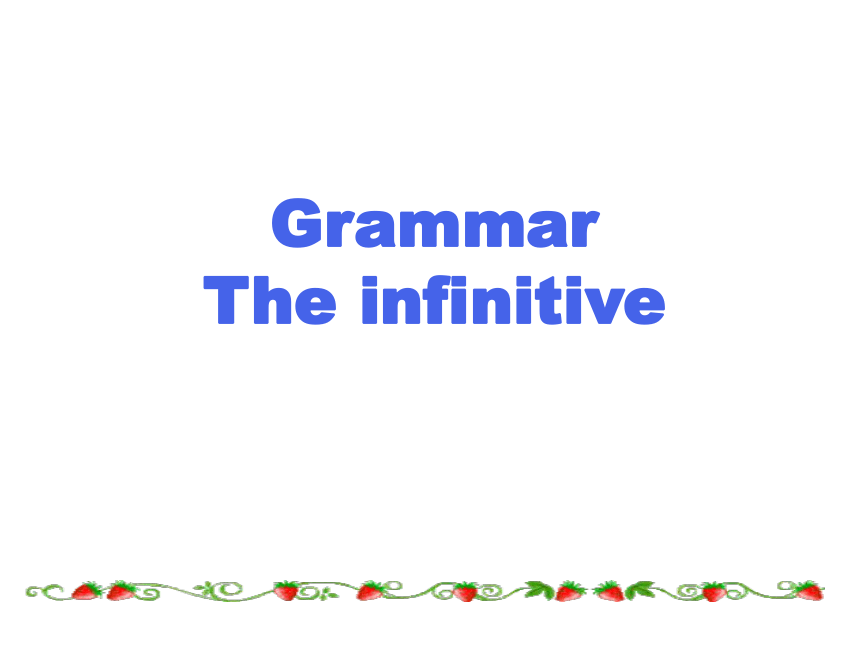 | |
| 格式 | zip | ||
| 文件大小 | 100.9KB | ||
| 资源类型 | 教案 | ||
| 版本资源 | 人教版(新课程标准) | ||
| 科目 | 英语 | ||
| 更新时间 | 2016-09-13 20:37:20 | ||
图片预览

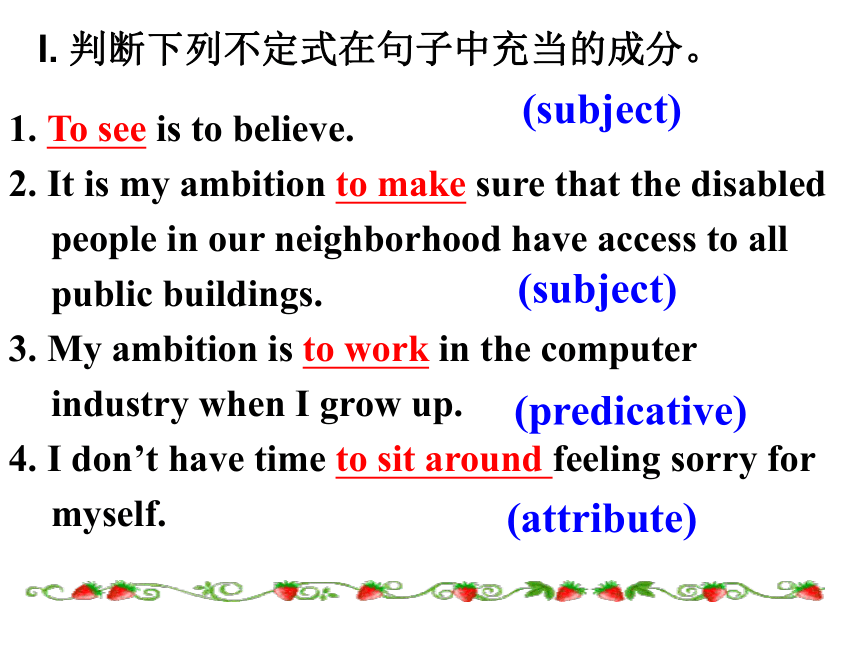


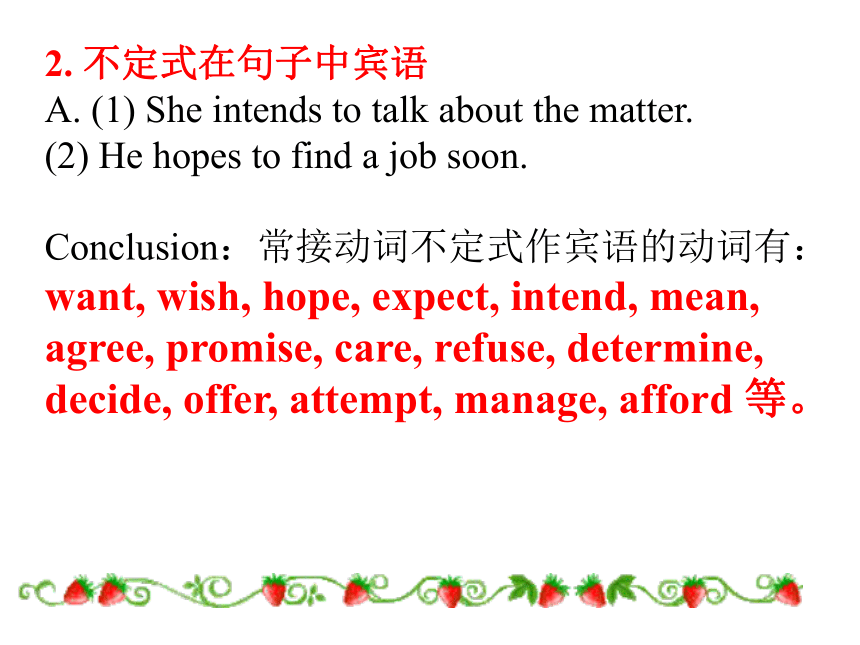
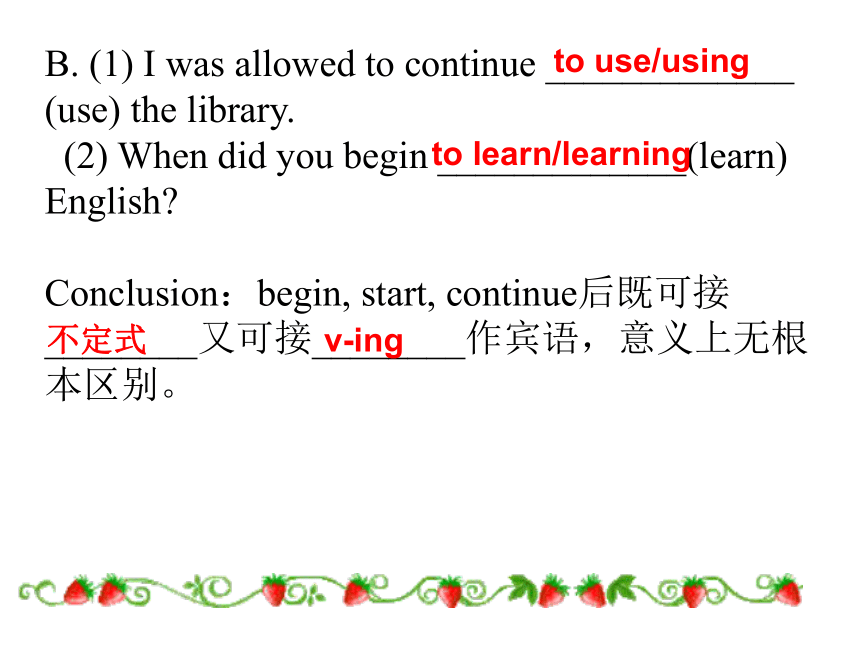
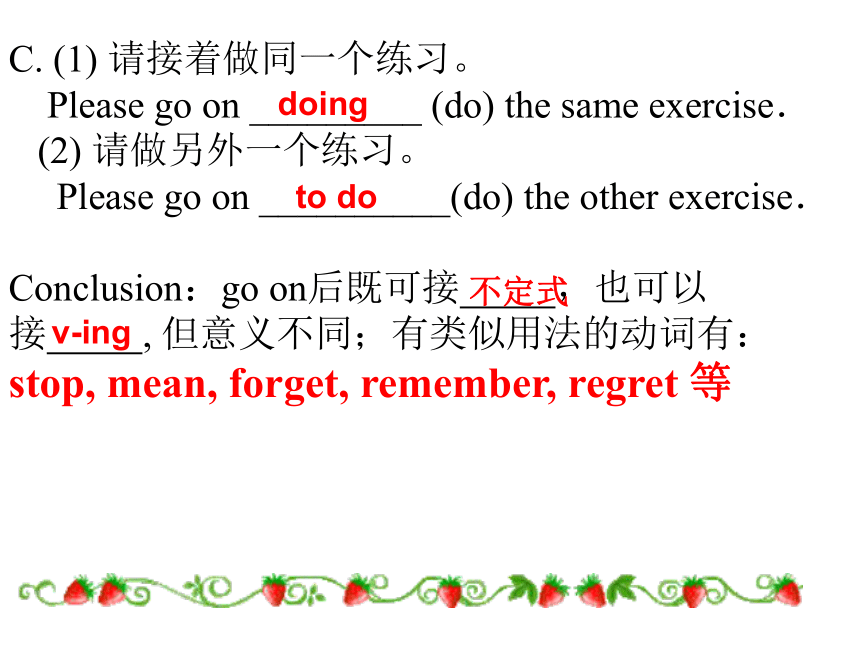
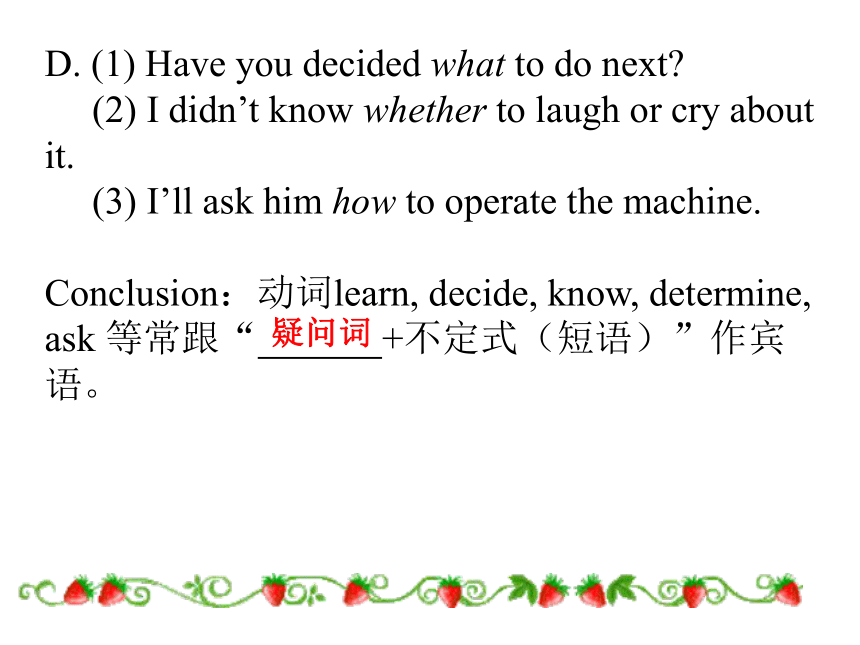
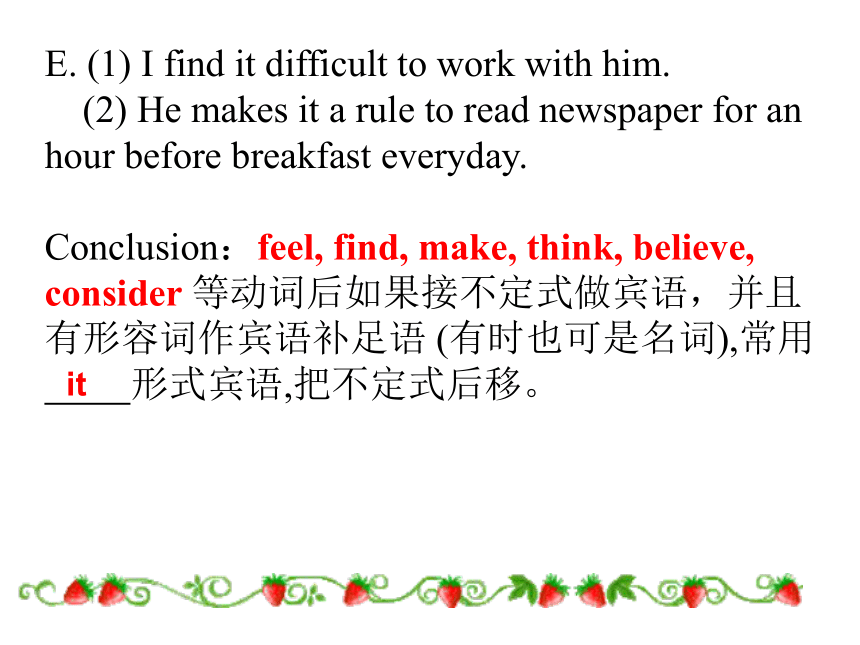
文档简介
课件26张PPT。Grammar
The infinitive1. To?see is to believe.
2. It is my ambition to make sure that the disabled people in our neighborhood have access to all public buildings.
3. My ambition is to work in the computer industry when I grow up.
4. I don’t have time to sit around feeling sorry for myself.
I. 判断下列不定式在句子中充当的成分。(subject)(subject)(predicative)(attribute)5. A big company has decided to buy it from me.
6. I have had to work hard to live a normal life.
7. Some days I am too tired to get out of bed.
8. We must call on local government to give financial assistance to disabled people.
(object)(adverbial)(adverbial)(object complement)Conclusion: 不定式由“ to+动词原形”构成,没有人称和数的变化,在句中不能独立作谓语。不定式在句中可作_____, _____, _____, _____, _____, _____。主语宾语补足语状语定语宾语表语Ⅱ. 不定式在句子中的成分
1. 不定式在句子中做主语
(1) To act like that is childish.
(2) It is not easy to learn English well.
(3) It calls for a great deal of memory work to master a foreign language.
Conclusion:为避免句子出现 “头重脚轻”现象, 常用 做形式主语,将真正主语的不定式后置。
it2. 不定式在句子中宾语
A. (1) She intends to talk about the matter.
(2) He hopes to find a job soon.
Conclusion:常接动词不定式作宾语的动词有:
want, wish, hope, expect, intend, mean, agree, promise, care, refuse, determine, decide, offer, attempt, manage, afford 等。
B. (1) I was allowed to continue _____________ (use) the library.
(2) When did you begin _____________(learn) English?
Conclusion:begin, start, continue后既可接________又可接________作宾语,意义上无根本区别。
to use/usingto learn/learning不定式v-ingC. (1) 请接着做同一个练习。
Please go on _________ (do) the same exercise.
(2) 请做另外一个练习。
Please go on __________(do) the other exercise.
Conclusion:go on后既可接 ,也可以接 , 但意义不同;有类似用法的动词有:
stop, mean, forget, remember, regret 等
doingto do不定式v-ingD. (1) Have you decided what to do next?
(2) I didn’t know whether to laugh or cry about it.
(3) I’ll ask him how to operate the machine.
Conclusion:动词learn, decide, know, determine, ask 等常跟“ +不定式(短语)”作宾语。
疑问词E. (1) I find it difficult to work with him.
(2) He makes it a rule to read newspaper for an hour before breakfast everyday.
Conclusion:feel, find, make, think, believe, consider 等动词后如果接不定式做宾语,并且有形容词作宾语补足语 (有时也可是名词),常用
形式宾语,把不定式后移。
itF. (1) We had no alternative but to fire him.
(2) Peter is not going anywhere except to work.
Conclusion:介词 和 后也可以跟不定式做宾语。
butexcept3. 不定式在句子做表语
(1) My work is to clean the room every day.
(2) His dream is to be a doctor.
Conclusion:不定式做表语常常表示主语的“职业、职责或性质”。
4. 不定式在句子中做定语
(1) I have a lot of work to do.
(2) She is the first student to come to school.
Conclusion:不定式放在被修饰的名词、代词的 。
后面5. 不定式在句子中做宾语补足语
A. (1) Father will not allow us to play on the street.
(2) Mr. Smith encouraged us to stick to the plan.
Conclusion:在下列动词后,常接带动词不定式做宾语补足语:
allow, permit, encourage, forbid, promise, wish, expect, prefer, tell, ask, order, require, force, warn, instruct, consider, cause, invite, advise, persuade, get, leave 等。
B. (1) The policeman saw a child play in the street.
(2) The teacher made the students do all the cleaning work for their parents at weekend.
(3) We noticed a stranger our dorm. (enter)
Conclusion:在下列动词后,常接 做宾语补足语:let, hear, have, make, see, observe, feel, watch, notice 等.
enter省略to的不定式注意:一旦将这类句子中的宾语改成主语,或者说,变为被动语态,此时的“宾语补语”就成为“主语补语”了,故不定式符号 to 不可省略。
(1) A child was seen to play in the street by the policeman.
(2) The students were made to do all the cleaning work for their parents at weekend.
(3) A stranger was noticed our dorm. (enter)
to enterC. With something to buy, he hurried to the supermarket.
Conclusion: with/ without 复合结构中,不定式也可以做宾语补足语。
6. 不定式在句子做状语
(1) To learn English well, I get up early to memorize English words every morning.
(2) I’m glad to see you.
(3) He is old enough to go to school.
Conclusion: 不定式(短语)在句子做状语,主要表目的、原因和结果等。
Ⅲ. 不定式的否定结构
1. 请告诉你的小孩不要在街上玩耍。
Please tell your child not to play in the street.
2. 她检查名字为了不犯错误.
She checked the names so as not to make mistakes.
Conclusion:不定式的否定结构为: .
not +不定式Ⅳ. 不定式的时态
1. 不定式的完成式
(1) I’m sorry to have given you so much trouble.
(2) She seems to have forgotten what she was looking for.
Conclusion:完成时表示的动作发生在谓语动词表示的动作 。
之前
2. 不定式的进行式
(1) He seems to be eating something.
It’s nice to be sitting here with you.?
Conclusion:一般进行时表示的动作正在进行,与谓语动词表示的动作同时发生。3. 不定式的完成进行式
She is said to have been working on the problem for many years.
据说她研究这问题有好多年了。
Conclusion:完成进行时表示动作从过去开始并延续至现在。Ⅴ. 不定式的被动式
1. The new drug is to be tested (out) on 500 overweight patients next year.
2. The company’s new car has to be designed in two months.
Conclusion: 不定式的被动式由“ to be +过去分词 ”构成。当不定式与逻辑主语之间是被动关系时,要用不定式的被动式。Ⅲ. 不定式的否定结构
1. 请告诉你的小孩不要在街上玩耍。
Please tell your child not to play in the street.
2. 她检查名字为了不犯错误.
She checked the names so as not to make mistakes.
Conclusion:不定式的否定结构为: .
not +不定式CBACABAAABB. 根据汉语提示,补全下列句子。
1. It had no effect except (让她生气).
2. The question of (使用什么) has not been discussed.
3. I’ll leave him (自己解决这个问题).
4. I have nothing (可担忧的).
to make her angrywhat to useto solve the problem himselfto worry about5. He asked (被派往农村工作).
6. (因为有两个儿子要上大学) this autumn, he has to work hard day and night to make more money.
7. is difficult for him (向你道歉).
My dream is (创立一家自己的公司).
to be sent to work in the countrysideWith two sons to go to collegeIt to make an apology to youto set up a company of my own
2. It is my ambition to make sure that the disabled people in our neighborhood have access to all public buildings.
3. My ambition is to work in the computer industry when I grow up.
4. I don’t have time to sit around feeling sorry for myself.
I. 判断下列不定式在句子中充当的成分。(subject)(subject)(predicative)(attribute)5. A big company has decided to buy it from me.
6. I have had to work hard to live a normal life.
7. Some days I am too tired to get out of bed.
8. We must call on local government to give financial assistance to disabled people.
(object)(adverbial)(adverbial)(object complement)Conclusion: 不定式由“ to+动词原形”构成,没有人称和数的变化,在句中不能独立作谓语。不定式在句中可作_____, _____, _____, _____, _____, _____。主语宾语补足语状语定语宾语表语Ⅱ. 不定式在句子中的成分
1. 不定式在句子中做主语
(1) To act like that is childish.
(2) It is not easy to learn English well.
(3) It calls for a great deal of memory work to master a foreign language.
Conclusion:为避免句子出现 “头重脚轻”现象, 常用 做形式主语,将真正主语的不定式后置。
it2. 不定式在句子中宾语
A. (1) She intends to talk about the matter.
(2) He hopes to find a job soon.
Conclusion:常接动词不定式作宾语的动词有:
want, wish, hope, expect, intend, mean, agree, promise, care, refuse, determine, decide, offer, attempt, manage, afford 等。
B. (1) I was allowed to continue _____________ (use) the library.
(2) When did you begin _____________(learn) English?
Conclusion:begin, start, continue后既可接________又可接________作宾语,意义上无根本区别。
to use/usingto learn/learning不定式v-ingC. (1) 请接着做同一个练习。
Please go on _________ (do) the same exercise.
(2) 请做另外一个练习。
Please go on __________(do) the other exercise.
Conclusion:go on后既可接 ,也可以接 , 但意义不同;有类似用法的动词有:
stop, mean, forget, remember, regret 等
doingto do不定式v-ingD. (1) Have you decided what to do next?
(2) I didn’t know whether to laugh or cry about it.
(3) I’ll ask him how to operate the machine.
Conclusion:动词learn, decide, know, determine, ask 等常跟“ +不定式(短语)”作宾语。
疑问词E. (1) I find it difficult to work with him.
(2) He makes it a rule to read newspaper for an hour before breakfast everyday.
Conclusion:feel, find, make, think, believe, consider 等动词后如果接不定式做宾语,并且有形容词作宾语补足语 (有时也可是名词),常用
形式宾语,把不定式后移。
itF. (1) We had no alternative but to fire him.
(2) Peter is not going anywhere except to work.
Conclusion:介词 和 后也可以跟不定式做宾语。
butexcept3. 不定式在句子做表语
(1) My work is to clean the room every day.
(2) His dream is to be a doctor.
Conclusion:不定式做表语常常表示主语的“职业、职责或性质”。
4. 不定式在句子中做定语
(1) I have a lot of work to do.
(2) She is the first student to come to school.
Conclusion:不定式放在被修饰的名词、代词的 。
后面5. 不定式在句子中做宾语补足语
A. (1) Father will not allow us to play on the street.
(2) Mr. Smith encouraged us to stick to the plan.
Conclusion:在下列动词后,常接带动词不定式做宾语补足语:
allow, permit, encourage, forbid, promise, wish, expect, prefer, tell, ask, order, require, force, warn, instruct, consider, cause, invite, advise, persuade, get, leave 等。
B. (1) The policeman saw a child play in the street.
(2) The teacher made the students do all the cleaning work for their parents at weekend.
(3) We noticed a stranger our dorm. (enter)
Conclusion:在下列动词后,常接 做宾语补足语:let, hear, have, make, see, observe, feel, watch, notice 等.
enter省略to的不定式注意:一旦将这类句子中的宾语改成主语,或者说,变为被动语态,此时的“宾语补语”就成为“主语补语”了,故不定式符号 to 不可省略。
(1) A child was seen to play in the street by the policeman.
(2) The students were made to do all the cleaning work for their parents at weekend.
(3) A stranger was noticed our dorm. (enter)
to enterC. With something to buy, he hurried to the supermarket.
Conclusion: with/ without 复合结构中,不定式也可以做宾语补足语。
6. 不定式在句子做状语
(1) To learn English well, I get up early to memorize English words every morning.
(2) I’m glad to see you.
(3) He is old enough to go to school.
Conclusion: 不定式(短语)在句子做状语,主要表目的、原因和结果等。
Ⅲ. 不定式的否定结构
1. 请告诉你的小孩不要在街上玩耍。
Please tell your child not to play in the street.
2. 她检查名字为了不犯错误.
She checked the names so as not to make mistakes.
Conclusion:不定式的否定结构为: .
not +不定式Ⅳ. 不定式的时态
1. 不定式的完成式
(1) I’m sorry to have given you so much trouble.
(2) She seems to have forgotten what she was looking for.
Conclusion:完成时表示的动作发生在谓语动词表示的动作 。
之前
2. 不定式的进行式
(1) He seems to be eating something.
It’s nice to be sitting here with you.?
Conclusion:一般进行时表示的动作正在进行,与谓语动词表示的动作同时发生。3. 不定式的完成进行式
She is said to have been working on the problem for many years.
据说她研究这问题有好多年了。
Conclusion:完成进行时表示动作从过去开始并延续至现在。Ⅴ. 不定式的被动式
1. The new drug is to be tested (out) on 500 overweight patients next year.
2. The company’s new car has to be designed in two months.
Conclusion: 不定式的被动式由“ to be +过去分词 ”构成。当不定式与逻辑主语之间是被动关系时,要用不定式的被动式。Ⅲ. 不定式的否定结构
1. 请告诉你的小孩不要在街上玩耍。
Please tell your child not to play in the street.
2. 她检查名字为了不犯错误.
She checked the names so as not to make mistakes.
Conclusion:不定式的否定结构为: .
not +不定式CBACABAAABB. 根据汉语提示,补全下列句子。
1. It had no effect except (让她生气).
2. The question of (使用什么) has not been discussed.
3. I’ll leave him (自己解决这个问题).
4. I have nothing (可担忧的).
to make her angrywhat to useto solve the problem himselfto worry about5. He asked (被派往农村工作).
6. (因为有两个儿子要上大学) this autumn, he has to work hard day and night to make more money.
7. is difficult for him (向你道歉).
My dream is (创立一家自己的公司).
to be sent to work in the countrysideWith two sons to go to collegeIt to make an apology to youto set up a company of my own
